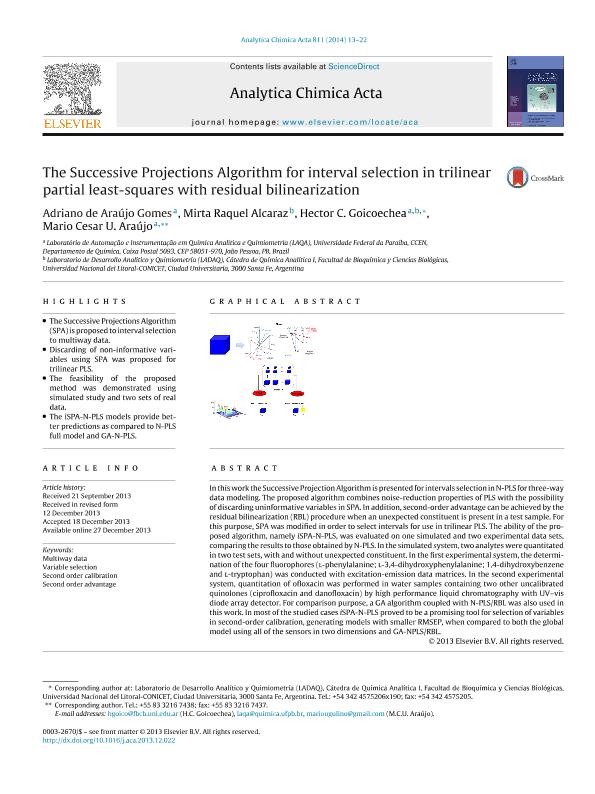Mostrar el registro sencillo del ítem
dc.contributor.author
Araújo Gomes, Adriano de
dc.contributor.author
Alcaraz, Mirta Raquel

dc.contributor.author
Goicoechea, Hector Casimiro

dc.contributor.author
Araújo, Mario Cesar U.
dc.date.available
2017-12-21T15:29:44Z
dc.date.issued
2013-12
dc.identifier.citation
Araújo, Mario Cesar U.; Goicoechea, Hector Casimiro; Alcaraz, Mirta Raquel; Araújo Gomes, Adriano de; The Successive Projections Algorithm for interval selection in trilinear partial least-squares with residual bilinearization; Elsevier; Analytica Chimica Acta; 811; 12-2013; 13-22
dc.identifier.issn
0003-2670
dc.identifier.uri
http://hdl.handle.net/11336/31217
dc.description.abstract
In this work the Successive Projection Algorithm is presented for intervals selection in N-PLS for three-way data modeling. The proposed algorithm combines noise-reduction properties of PLS with the possibility of discarding uninformative variables in SPA. In addition, second-order advantage can be achieved by the residual bilinearization (RBL) procedure when an unexpected constituent is present in a test sample. For this purpose, SPA was modified in order to select intervals for use in trilinear PLS. The ability of the proposed algorithm, namely iSPA-N-PLS, was evaluated on one simulated and two experimental data sets, comparing the results to those obtained by N-PLS. In the simulated system, two analytes were quantitated in two test sets, with and without unexpected constituent. In the first experimental system, the determination of the four fluorophores (l-phenylalanine; l-3,4-dihydroxyphenylalanine; 1,4-dihydroxybenzene and l-tryptophan) was conducted with excitation-emission data matrices. In the second experimental system, quantitation of ofloxacin was performed in water samples containing two other uncalibrated quinolones (ciprofloxacin and danofloxacin) by high performance liquid chromatography with UV–vis diode array detector. For comparison purpose, a GA algorithm coupled with N-PLS/RBL was also used in this work. In most of the studied cases iSPA-N-PLS proved to be a promising tool for selection of variables in second-order calibration, generating models with smaller RMSEP, when compared to both the global model using all of the sensors in two dimensions and GA-NPLS/RBL.
dc.format
application/pdf
dc.language.iso
eng
dc.publisher
Elsevier

dc.rights
info:eu-repo/semantics/openAccess
dc.rights.uri
https://creativecommons.org/licenses/by-nc-sa/2.5/ar/
dc.subject
Multiway Data
dc.subject
Variable Selection
dc.subject
Second Order Advantage
dc.subject
Second Order Calibration
dc.subject.classification
Otras Ciencias Químicas

dc.subject.classification
Ciencias Químicas

dc.subject.classification
CIENCIAS NATURALES Y EXACTAS

dc.title
The Successive Projections Algorithm for interval selection in trilinear partial least-squares with residual bilinearization
dc.type
info:eu-repo/semantics/article
dc.type
info:ar-repo/semantics/artículo
dc.type
info:eu-repo/semantics/publishedVersion
dc.date.updated
2017-12-21T14:07:20Z
dc.journal.volume
811
dc.journal.pagination
13-22
dc.journal.pais
Países Bajos

dc.journal.ciudad
Ámsterdam
dc.description.fil
Fil: Araújo Gomes, Adriano de. Universidade Federal da Paraíba; Brasil
dc.description.fil
Fil: Alcaraz, Mirta Raquel. Universidad Nacional del Litoral. Facultad de Bioquímica y Ciencias Biológicas; Argentina. Consejo Nacional de Investigaciones Científicas y Técnicas. Centro Científico Tecnológico Conicet - Santa Fe; Argentina
dc.description.fil
Fil: Goicoechea, Hector Casimiro. Universidade Federal da Paraíba; Brasil. Universidad Nacional del Litoral. Facultad de Bioquímica y Ciencias Biológicas; Argentina. Consejo Nacional de Investigaciones Científicas y Técnicas. Centro Científico Tecnológico Conicet - Santa Fe; Argentina
dc.description.fil
Fil: Araújo, Mario Cesar U.. Universidade Federal da Paraíba; Brasil
dc.journal.title
Analytica Chimica Acta

dc.relation.alternativeid
info:eu-repo/semantics/altIdentifier/url/http://www.sciencedirect.com/science/article/pii/S0003267013015717
dc.relation.alternativeid
info:eu-repo/semantics/altIdentifier/doi/http://dx.doi.org/10.1016/j.aca.2013.12.022
Archivos asociados
